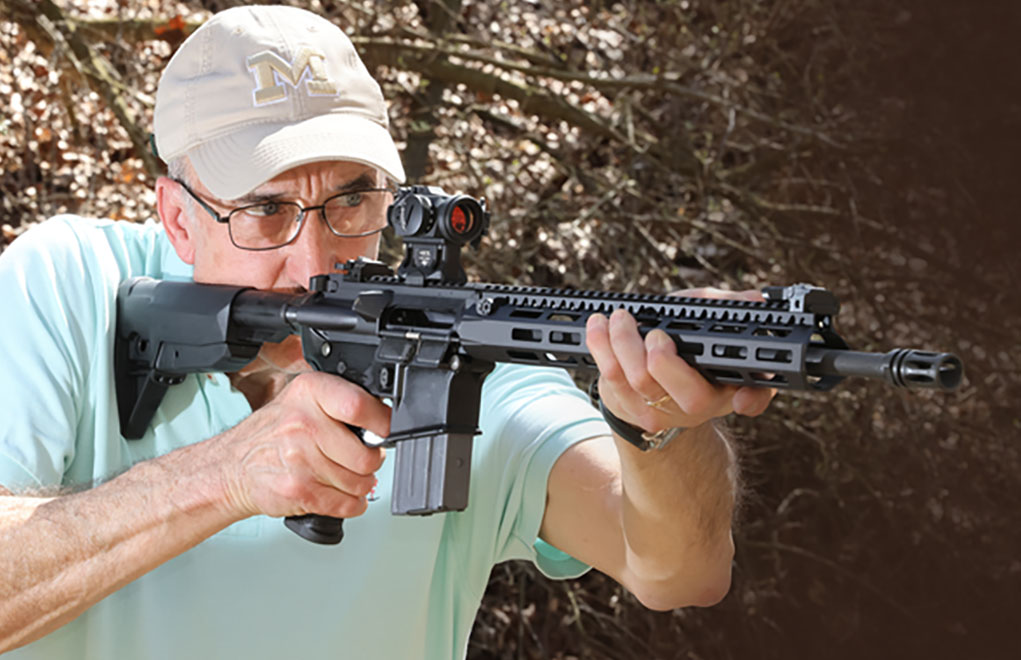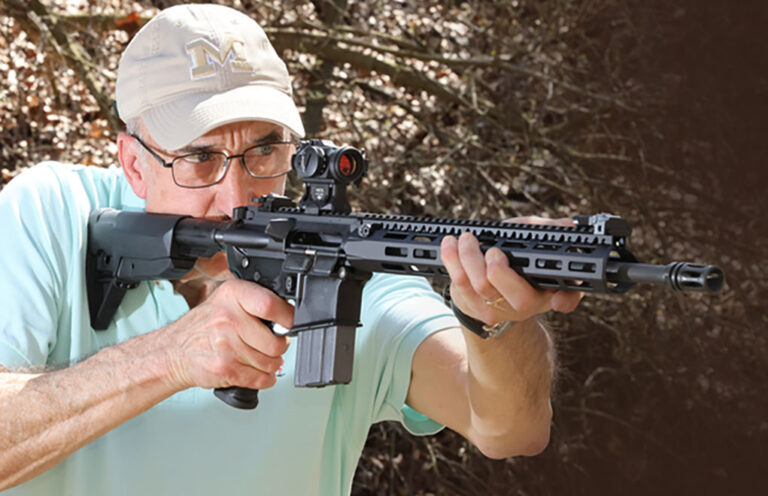
We put together a lightweight AR build that’s designed to be used hard with some help from Bravo Company USA.
Most articles on building a lightweight AR-15 end up veering into some sort of bizarre “what the heck?” universe. The results are often a “rifle” that incorporates exotic materials of fabulous cost, with the various parts having more piercings than a 19-year-old purple-haired coed at a liberal arts college, and a “full up” weight of 3.5 pounds.
And, if you drop it, it breaks.
Yes, I want lightweight, but I expect my tools to work—and to survive at least as much hard use as I myself can withstand. It has been a long time since I willingly jumped out of perfectly serviceable aircraft (at my own expense, not courtesy of Uncle Sam, to be clear), but I still trip and fall now and then. So, at the very least, I expect a rifle I’ve fallen on to still work.
To that end, I rang up Paul Buffoni at Bravo Company USA (BCM) to see what we could do.
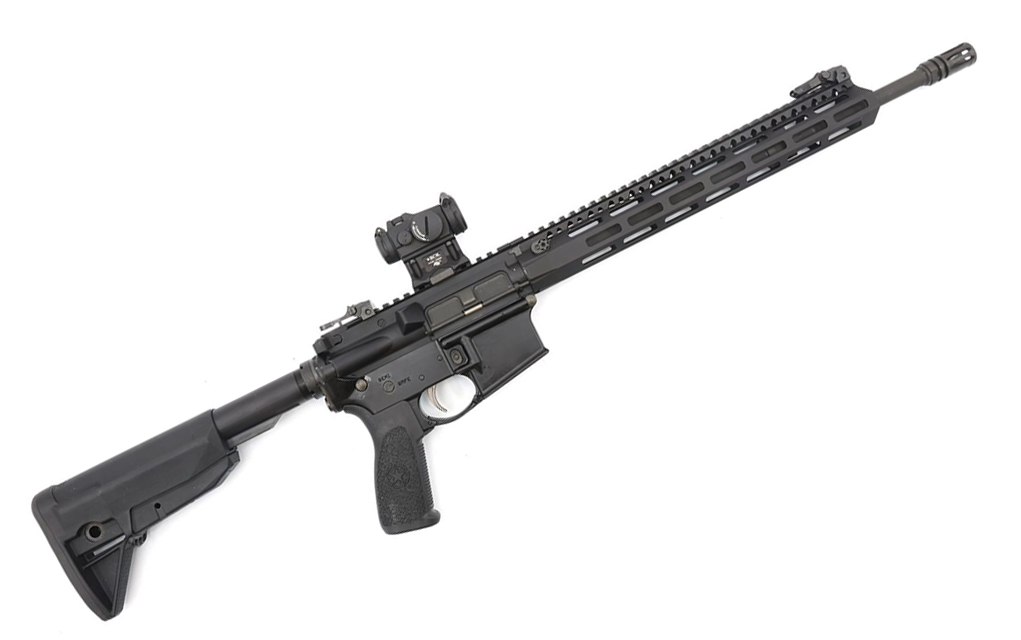
Building A Lightweight Bruiser
On the lower, there wasn’t much. Short of chopping holes in things, or using polymer (which both of us agreed was out of bounds), a basic AR-15 lower was going to weigh what a lower weighs. For this project, that meant a lower that weighs 35.6 ounces.
Now, that’s with the BCM Mod 0 stock, and this is where I get to cheat a bit if I want to. The Mod 0 stock, while very comfortable, is heavier than needed. So, if I swap that for a plain ol’ CAR-15 stock, I can shave off a grand total of 3.9 ounces.
Hmm, for comfort’s sake, I’ll keep the Mod 0 thank you very much.
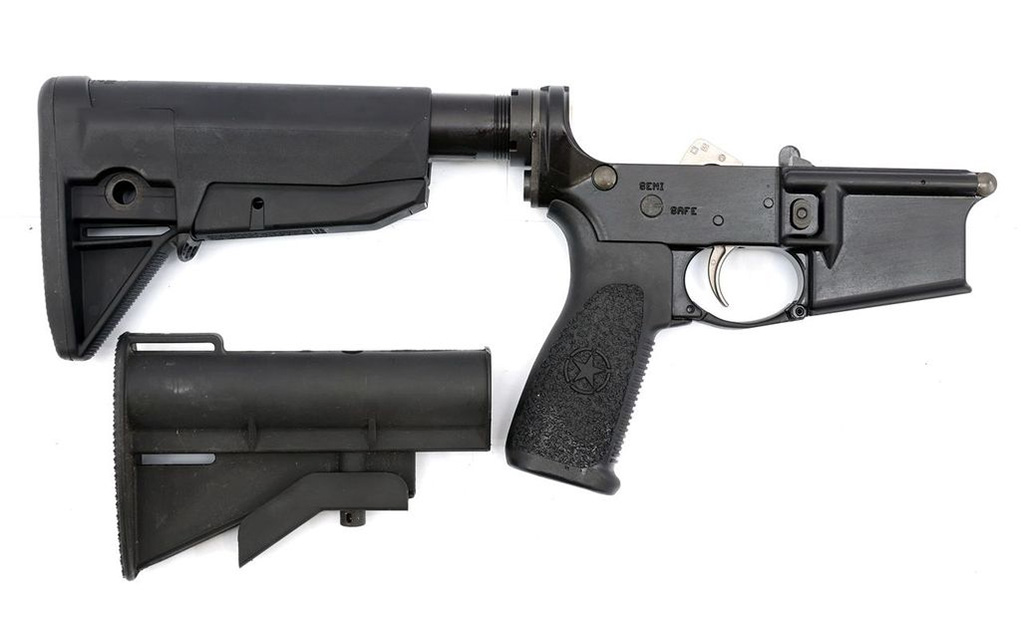
The BCM lower came assembled (I like a project, but I’m not a masochist), and that included their PNT trigger assembly, which is made of investment castings in 8620, precision machined, and then after the sear surfaces have been surface ground and polished, it gets a nickel-Teflon coating. It’s Mil-spec tough but nearly High Power clean and crisp.
In addition to the Mod 0 stock, it had a BCM Mod 3 pistol grip. I much prefer the original Mod 0 grip, but this is how it came, and they’re easy enough to swap that I’m not worried. There was nothing to be done with the lower, nor would I want to, so that part was easy.
However, the upper is something we can make some progress on.
Buffoni is justifiably proud of his single-side Mk2 (medium) charging handle, and I can’t see adding enough weight to justify a USGI handle, so we’re in at one full ounce. A bolt and carrier are the same regardless, but the BCM parts are all Mil-spec, tested and top-notch, so there’s 11.5 ounces. That leaves the receiver and handguard.
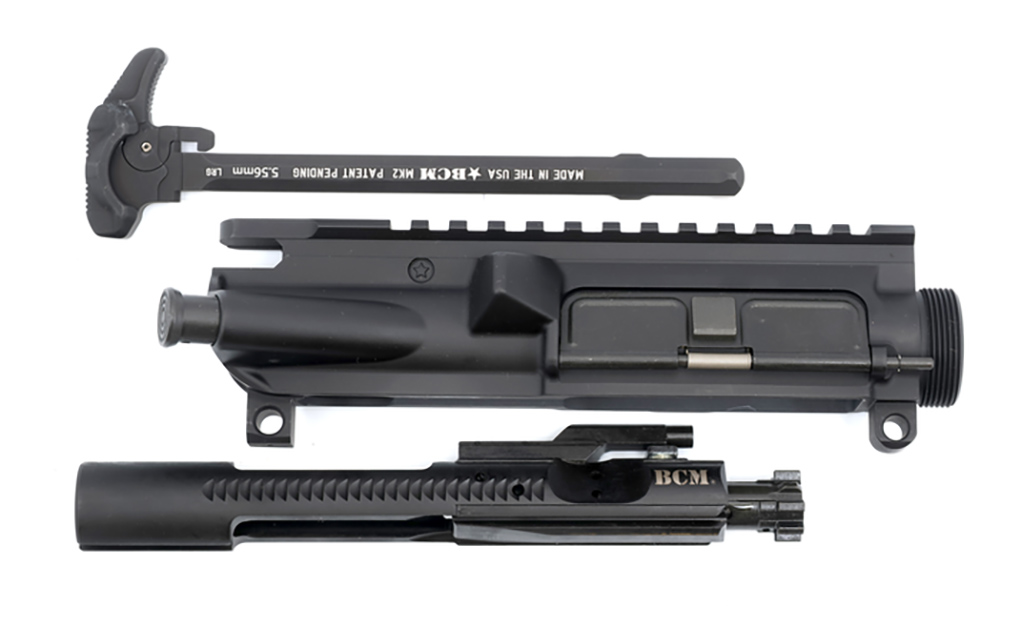
For a receiver, we went with a flat-top M4 because … well, why not? And if I need iron sights (and I do, we’ll cover that later), I don’t want them in a carry handle. So, I went with the flat-top to give me sighting options and the M4 because I want the M4 feedramps. There’s another 8.3 ounces.
Choosing a Bullet Tube
OK, now what for a barrel?
Another cheat that people use to minimize weight is to make an AR pistol or an SBR. By foregoing 5 to 7 inches of 4150 steel tube, they can shave off a significant amount of weight. Yeah, no. I’m not a real fan of AR pistols, and not everyone can have, or be willing to go through the hassle of getting, an SBR.
So, a carbine it is.
I could go with a 14.5-inch barrel and a pinned and welded flash hider, but the weight savings end up being minimal at best. What to do? Simple: flutes. Bravo offers a 16-inch fluted, lightweight 5.56 barrel that tips the scales at 22 ounces. (By comparison, a 14.5-inch of the same weighs 20.5 ounces. But you still need a flash hider long enough to make it to 16 inches, so there goes most or all of your 1.5 ounces “saved.”)

The lightweight barrel is fluted, but it’s already such a slim tube that the fluting isn’t the “drainage ditch” you might expect. They’re shallow, but they do shave some weight off. The overall profile of the barrel is so slim that the gas block doesn’t have a shoulder to stop on. And the stop-shoulder at the muzzle for the flash hider? That has to be increased from the barrel diameter, so the flash hider and its washer have enough of a shoulder to actually stop and torque up to.
A low-profile gas block and gas tube add to the ensemble, and they’re going to weigh the same regardless of what barrel you use. Lacking a stop shoulder and not enough steel to permit a crosspin, the gas block has to depend on a small dimple and two setscrews.
I’m usually not a fan of set screws for this application. In fact, I’d be really leery, except for one thing: The handguard fully covers the gas block. It can’t get impacted, so it can’t shift—especially when I use Loctite on the setscrews, and wicking Loctite between the barrel and gas block. I’ve done it this way before, and—done right—things stay in place.
That leaves the handguard. I could go retro and stick with the plastic carbine or rifle-length ribbed handguards, but if I wanted to mount a light, I’d be out of luck. Plus, that means an A-frame front sight, and those add weight.
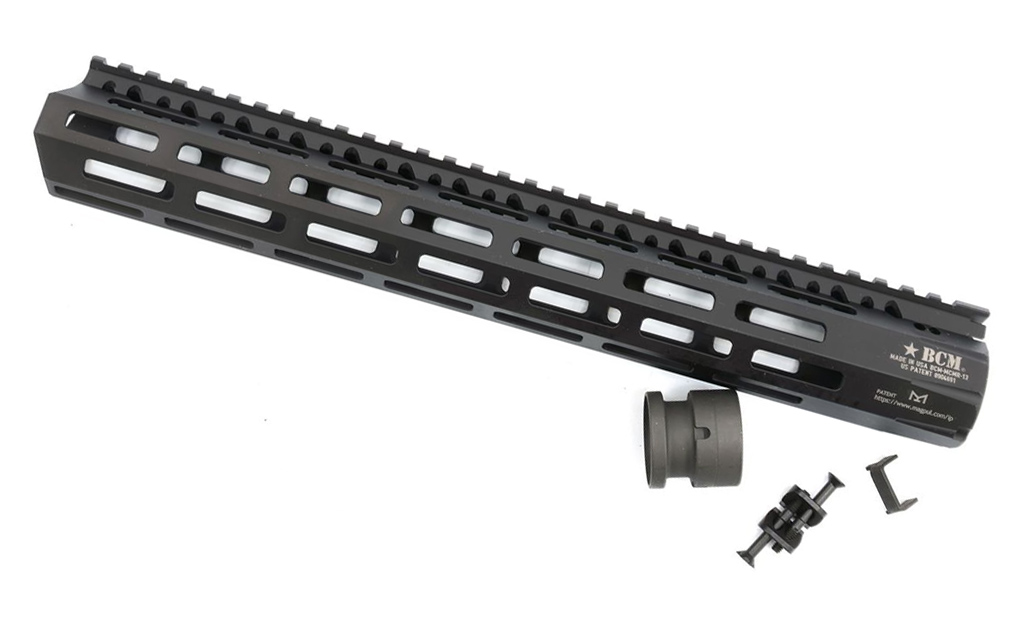
So, I went with the Bravo Company MCMR13, an M-Lok-slotted aluminum handguard that free-floats the barrel and adds only 10.5 ounces to the overall weight. Now, I could opt for the MCMR10, the carbine-length handguard, and shave it back to 9 ounces, but I have long arms and the extra length (sigh, an extra ounce-and-a-half of aluminum) makes things easier. The MCMR uses a proprietary barrel nut (with wrench included) and an anti-rotation steel clip. It also uses a pair of through-bolts to clamp it in place.
How do I know all these weights? I’d like to say I was diligent and weighed them all (I did), but for that I have to give Buffoni credit. Being curious and weight-conscious, he weighs all the gear to keep track. All parts in the mix, he calculated that the weight so far (no sights, sling or magazine) would come to 90.5 ounces … or 5.66 pounds. That’s pretty darned light, considering that my XM177E1 clone tips the scales at that same weight.
But that weight has no provision for optics or light.
Icing the Cake
Buffoni shipped the parts, and I got to work. I could’ve had it sent as a complete rifle, but where’s the fun in that? I know how to assemble an AR-15, and when all the parts come from Bravo, you know they will all play well with each other.
For sighting, I opted for the BCM optics mount, a heck-for-tough steel mount (OK, an extra ounce or two, darn) that’s not a QD mount, and an Aimpoint T2. For all of it being steel and tough, the mount weighs less (2.6 ounces) than the Aimpoint (3.4 ounces), or the backup irons I insist on.
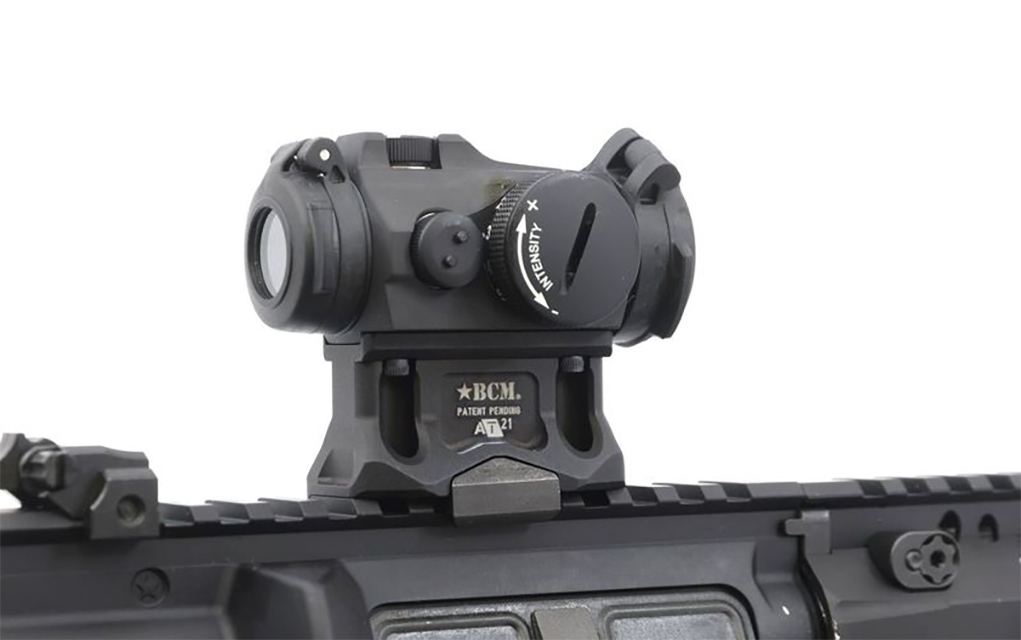
Yes, for a lightweight rifle, I’ll add the weight of some backup sights, and here I opted for the Mission First Tactical folding BUIS in steel. At 3.1 ounces, they’re not heavy, but the extra ounce or so I might have saved by going aluminum or polymer just doesn’t interest me. If the situation has gone sideways enough that I need my BUIS, I want something that will survive the experience.
Where does that leave us? With the 5 pounds, 10.5 ounces of our start weight, I added 9.1 ounces of sighting hardware. That puts the bare rifle up to 6 pounds and 3.6 ounces. Add in a sling and a loaded 20-round magazine, and we’re under 7 pounds, ready to go.
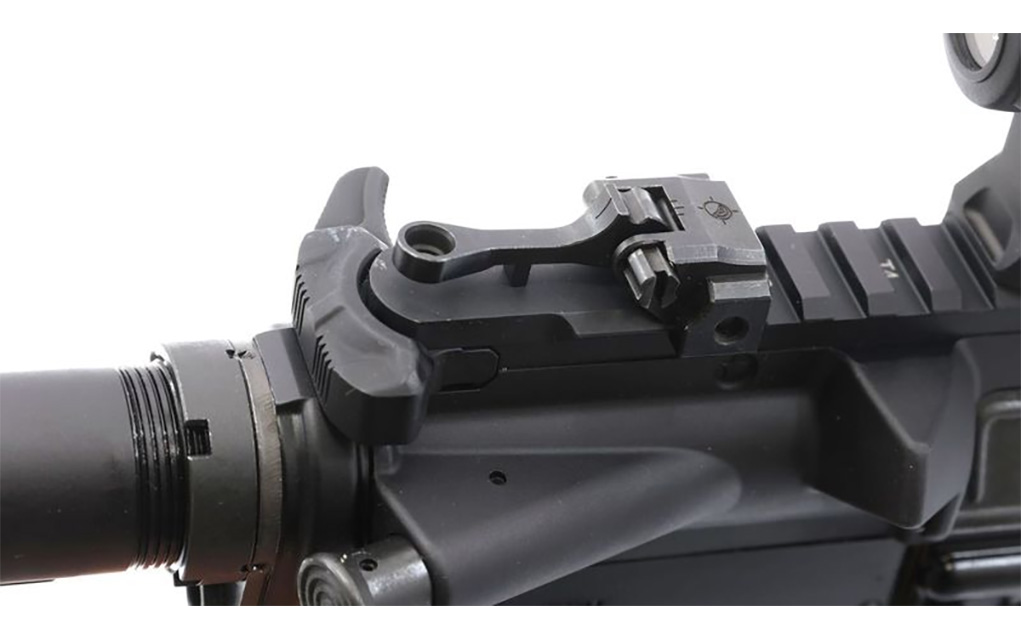
Admittedly, there’s no light mounted, but lights can have weights all over the map. (If you don’t mind me mixing my metaphors.) You could go as light as a no-longer-made Insight M3 (I’ve got a basket of them) for 3.3 ounces, or go up to “signal the mothership illumination” SureFire M640DFT-Pro at 5.5 ounces.
Even with a light, we’re barely over 7 pounds, and the racks of gun shops across America are stuffed full of AR-15s that start out heavier than this and as bare as the day they were born. Oh, and a sling? I’m a minimalist, so we can count on that adding 2 to 3 ounces at most. Still supermodel skinny and lightweight.
It’s Lightweight, But Does It Shoot?
Test-firing? Really? You have to ask? The trigger makes consistent release a simple task, and the stock is comfortable enough to have a consistent cheek weld. Granted, the light weight means the BCM Lightweight is a bit sporty on the bags, but that’s only in the context of the AR-15.

Really, if the recoil of a 5.56 in a just-barely 7-pound rifle is something you find uncomfortable, you really need to eat your Wheaties. And when you consider that you’ll spend days, months and even years carrying the weight and minutes experiencing recoil, the trade-off is worth it.
Cost? That one was a puzzler. I had to pore over the Bravo Company catalog, keeping track of the various parts, to determine that … it was worth it. Then, I found out that Bravo could’ve saved me the trouble, because they make the exact upper I built, ready to go. So, order a basic BCM lower and their Enhanced lightweight fluted complete upper. After that, you’ll have to decide on sighting options yourself—but that’s the fun part.
Bravo Company AR Build Specs:
- Type: Semi-auto carbine
- Caliber: 5.56x45mm NATO
- Capacity: 30+1 (Uses AR-15 magazines)
- Barrel: 16 Inches
- Length: 34 Inches
- Width: 1.3 Inches
- Height: 7 Inches
- Weight: 6 Pounds, 4 Ounces
- Trigger: 5 Pounds, 1 Ounce
- Sights: MFT BUIS / Aimpoint T2 in BCM mount
- Grip: BCM Mod 3
- Finish: Black oxide, anodizing and polymer
- MSRP: $1,344
- Website: bravocompanyusa.com
Editor’s Note: This article originally appeared in the June 2024 issue of Gun Digest the Magazine.
More AR-15 Stuff:

Next Step: Get your FREE Printable Target Pack
Enhance your shooting precision with our 62 MOA Targets, perfect for rifles and handguns. Crafted in collaboration with Storm Tactical for accuracy and versatility.
Subscribe to the Gun Digest email newsletter and get your downloadable target pack sent straight to your inbox. Stay updated with the latest firearms info in the industry.
